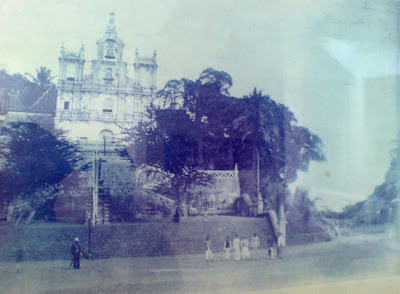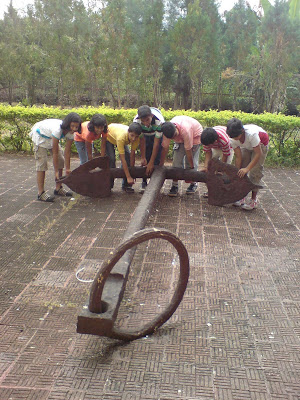Filled with desire to share Goa's glorious past with my kids and nephews and nieces, I bundled seven of them into the car and went off to Panjim. The Goa State Museum at Patto Plaza in Panjim is located at the end of a godforsaken road with no signs to guide any potential visitors.
.. .
The building itself is a woebegone two-storied concrete structure with no pretensions to any kind of architectural style. The structure is so ashamed of itself that over the years it has been trying to sink itself in the weak backfilled soil of Patto. The settlement of the structure has caused cracks in the floor and walls in several place. So much for the Glory of Goa, my kids were not impressed by the inglorious state of the museum!
..
The staff were helpful though, and provided us with brochures and directions. A large rath, a wooden temple chariot stands in the central court of the museum.

The Goa State Museum has sorted out its collection into these categories : Sculpture, Christian Art, Banerji Art Gallery, Religious Expression, Cultural Anthropology, Contemporary Art, Numismatic, Goa's Freedom Struggle Gallery, Menezes Braganza Art Gallery,Furniture Gallery, Environment and Development Gallery and other displays.
That''s quite a lot to ingest in one trip. It's best to view just a couple of galleries in one visit. Else the historic and aesthetic significance of the objects is diminished in the visual overload. Here are a few statues of religious figures from the Christian Art Gallery.
.


This stone statue is of a Portuguese queen, Dona Maria II. Check out the history of the Portuguese Coat of Arms. But I could not find information on the COA displayed on the shield in the photo. The other shield shows a Medusa head. ...
.......Maria II was born with the name "Maria da Glória Joana Carlota Leopoldina da Cruz Francisca Xavier de Paula Isidora Micaela Gabriela Rafaela Gonzaga de Áustria e Bragança" . Thank goodness she had staff at hand to fill in her school admission forms! ..............
.
.
. ....
One of the art galleries had these beautiful paintings. The one below is titled Queimada, which neans ''burn''. There is a film titled Queimada, starring MarlonBrando. The first photo shows the painting as well as the ghostly viewers in the museum. I tweaked the contrast to get the second picture, a darker and eerier image. It also looks like the fire is in its later, more anguished stage.


Another painting displayed (pic below) is titled Melancholia. The giant caterpillars and beetles and plants aptly conjure up the spectre of an overpowered life, whereupon the victim lapses into a brooding sadness. One of my favorite artists Edvard Munch has another portrayal of Melancholy.

The kids were quite taken up by the statuette blown by the wind.


This ironmonger towers in the photograph, but he is actually only a few inches tall. A clever camera angle does the trick. That's the way we must be, always larger than life!
. .
One of the largest single exhibits is the complexly(!) intricate Lottery draw machine of Provedoria. I guess they really did things in style those days. Today we would pick a crumpled lot from a jar to decide the winner.



Here's a Goan native in"''Christian dress''. The raw ethnic look in her face tells of a different time and circumstances altogether.



The kids had a whale of a time. They were energized and intoxicated enough by the knowledge they had imbibed, to try and lift the massive anchor that lay in the rear courtyard of the museum. They eventually hoisted it and tossed it into the Mandovi. Really.






1 comment:
I have always wanted to visit the State Museum but kept putting it off. Now that I have seen this excellent article I don't think I need to bother. Naah! Just joking. I think you've produced a great advertisement for the museum. Tell them to pay you for it Jose.
Post a Comment